
The Angolan slender mongoose is a mongoose native to southwestern Africa, specifically southwestern Angola and northwestern Namibia. It has been listed as Least Concern on the IUCN Red List, as it is not threatened and thought to be common. It has a long, slim body and there are different colour forms, a black or dark brown form in the southern part of its range, and a yellowish- or reddish-brown form in the north. This mongoose inhabits dry, rocky habitats and feeds on insects, scorpions and small vertebrates.
The Angolan hairy bat also known as Angolan wing-gland bat is a species of bat in the Cistugidae family. It can be found in hot deserts in Angola, Namibia, and South Africa.
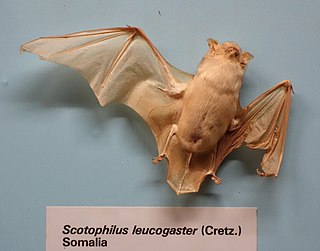
The white-bellied yellow bat or white-bellied house bat, is a species of vesper bat in the genus Scotophilus, the house bats. It can be found in Angola, Benin, Botswana, Burkina Faso, Cameroon, Central African Republic, Chad, Ivory Coast, Gambia, Ghana, Guinea, Guinea-Bissau, Kenya, Mali, Mauritania, Namibia, Niger, Nigeria, Senegal, Sierra Leone, Sudan, Togo, Uganda, and Zambia. It is found in dry and moist savanna and open woodland. It is a common species with a very wide range, and the International Union for Conservation of Nature has assessed its conservation status as being of "least concern".
The Zulu serotine, also called the Zulu pipistrelle, aloe bat, or aloe serotine, is a species of vesper bat found in Angola, Botswana, Democratic Republic of the Congo, Ethiopia, Kenya, Malawi, Namibia, South Africa, South Sudan, Uganda, Zambia, and Zimbabwe. Its natural habitats are savanna and hot deserts.
Tomopterna ahli, commonly known as the Damaraland sand frog or Damara sand frog, is a species of frog in the family Pyxicephalidae. It is found in central to north-western Namibia and southwestern Angola.
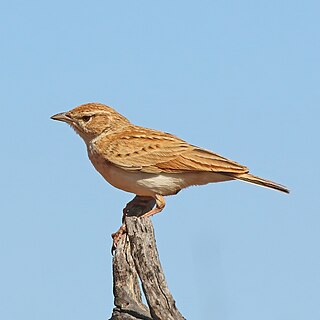
The fawn-coloured lark or fawn-coloured bush-lark is a species of lark in the family Alaudidae. It is found in south-central Africa.
The stone dormouse is a species of rodent in the family Gliridae. It is found in Namibia, South Africa, and possibly Angola. Its natural habitat is rocky areas in the Karoo. Though it has a limited range, it is a fairly common species and the International Union for Conservation of Nature has assessed its conservation status as being of "least concern".

The swamp musk shrew, or musk shrew, is a species of mammal in the family Soricidae. It occurs in Angola, Botswana, Democratic Republic of the Congo, Mozambique, Namibia, South Africa, Eswatini, Zambia and Zimbabwe. Its natural habitat is swamps, and it is a common species in suitable habitats, with the International Union for Conservation of Nature listing it as being of "least concern".

Axiocerses is a genus of butterflies in the family Lycaenidae. The species of this genus are found in the Afrotropical realm.

Colotis euippe is a butterfly of the family Pieridae that is found in the Afrotropical realm.

Colotis evagore, the desert orange tip, small orange tip, or tiny orange tip, is a butterfly of the family Pieridae. It is found in the dry parts of tropical Africa, northern Africa, southern Spain and southwest Arabia.

Axiocerses tjoane, the eastern scarlet, common scarlet or scarlet butterfly, is a butterfly of the family Lycaenidae. It is found in East and southern Africa.
Axiocerses croesus, the dark-banded scarlet, is a butterfly of the family Lycaenidae. It is found in the Eastern Cape, west up to Port Elizabeth and into Kwazulu-Natal.
Axiocerses coalescens, the black-tipped scarlet, is a butterfly of the family Lycaenidae. It is found in wooded savanna areas in Gauteng, Mpumalanga, Limpopo and north-western South Africa and further to the north.
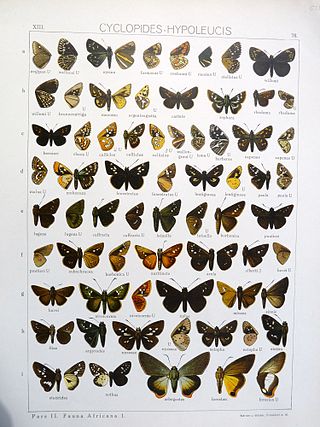
Nervia nerva, the scarce ranger or scarce skipper, is a species of butterfly of the family Hesperiidae. It is found in South Africa, Zimbabwe, Angola and north-western Zambia.
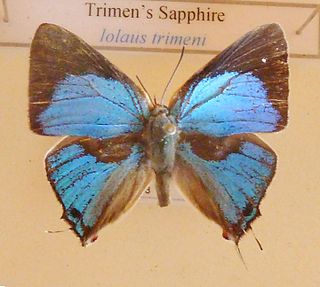
Iolaus trimeni, the Trimen's sapphire, is a butterfly of the family Lycaenidae. It is found in the southern Democratic Republic of the Congo, south-eastern Angola, Zambia, Tanzania, Malawi, Zimbabwe, Mozambique, Swaziland and South Africa. In South Africa it is found from northern KwaZulu-Natal to Mpumalanga, Gauteng and the North West province.

Iolaus pallene, the saffron sapphire, is a butterfly of the family Lycaenidae. It is found from southern Sudan, Angola, southern Democratic Republic of the Congo (Shaba) and Kenya to South Africa. In South Africa it is found from the thorn belt of KwaZulu-Natal and Eswatini to Mpumalanga, Gauteng, Limpopo and North West.

Myrina silenus, the common fig-tree blue, is a butterfly of the family Lycaenidae. It is found in Sub-Saharan Africa, southern Arabia and northern Oman.

Colotis antevippe, the red tip, is a butterfly of the family Pieridae. It is found in the Afrotropical realm.
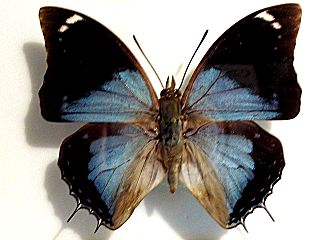
Charaxes bohemani, the large blue emperor, large blue charaxes or divebomber charaxes, is a butterfly of the family Nymphalidae. It is found in eastern and southern Africa.














